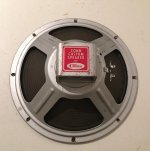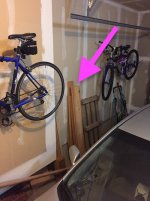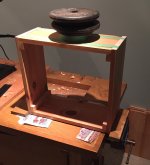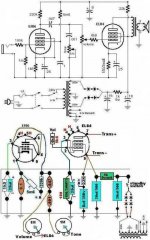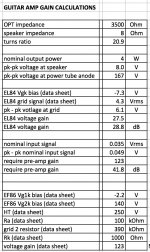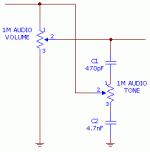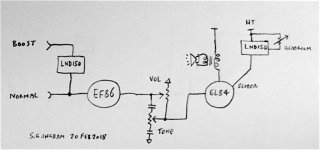Member
Joined 2009
Paid Member
This is all new to me. My household got a Telecaster for Christmas so we need an amp for it. I'm learning to play it, having no history of musical instruments whatsoever. My sister, in the UK, has an old Ibanez Roadster which also needs an amp (and she doesn't play either).
I decided to make a pair of practice amps using as many materials as I can lay my hands on. I want to use valves, seems to be a popular approach. And I have some single ended output transformers, some EL84's and other stuff. After reading around it seems like a VOX AC4 style circuit would be a good place to start.
I found some pine planks in my garage, been standing there for 20 years so now finally I get to saw them up and make. The planks are 3/4" thick and a bit rough. I also got a pair of old organ speakers, AlNiCo and 12" diameter. Cones look intact.
I could use some advice along the way....
I decided to make a pair of practice amps using as many materials as I can lay my hands on. I want to use valves, seems to be a popular approach. And I have some single ended output transformers, some EL84's and other stuff. After reading around it seems like a VOX AC4 style circuit would be a good place to start.
I found some pine planks in my garage, been standing there for 20 years so now finally I get to saw them up and make. The planks are 3/4" thick and a bit rough. I also got a pair of old organ speakers, AlNiCo and 12" diameter. Cones look intact.
I could use some advice along the way....
Attachments
Last edited:
Member
Joined 2009
Paid Member
Member
Joined 2009
Paid Member
It's a nice amp, a bit quiet, I added a 12ax7 in mine, after the EF86, and now it sounds amazing.
The downside is that the EF86 is expensive and microphonic in one of the vox circuits, not sure if it was this one or the ac15...
So, if you can, use some rubber rings to mount it to the chassis.
The downside is that the EF86 is expensive and microphonic in one of the vox circuits, not sure if it was this one or the ac15...
So, if you can, use some rubber rings to mount it to the chassis.
Member
Joined 2009
Paid Member
It's a nice amp, a bit quiet, I added a 12ax7 in mine, after the EF86, and now it sounds amazing.
I tried to see how much gain the amp needs and it looks doable with just the EF86 (attached). I calculated I'd need a front end gain of 123 to max out the output. My junk box OPT are 3.5k into 8R. I believe the EF86 could give a bit more gain, data sheet says 185. So I assume you added the 12AX7 to allow for overdriving the output stage ??
Attachments
Last edited:
It's a nice amp, a bit quiet, I added a 12ax7 in mine, after the EF86, and now it sounds amazing.
The downside is that the EF86 is expensive and microphonic in one of the vox circuits, not sure if it was this one or the ac15...
So, if you can, use some rubber rings to mount it to the chassis.
The EF86 is known (online, at least) for being microphonic in the AC15, which is why they replaced it with an ECC83.
I've owned a few AC15's over the years, but never one with an EF86, so I can't confirm/deny the allegation
I've been playing through a home made AC4 replica for about a year now, more or less the same circuit bigun posted, never had any problems with it. I think the microphony stemmed at least in part from the sheer amount of energy reverberating through a 15W 2x12 combo at full tilt, which I guess is how a lot of folk played them back in the day, since PA systems were primitive.
Perhaps worth mentioning that my 'AC4' is a head with a seperate cab, which will alleviate some of the potential for microphonics.
Matt.
And the basic schematic for the amp that I found on the 'net
Hi,
I've been playing through a homemade AC4 for about a year now. Sounds great but - to some extent depending on the speaker choice - is way too loud to get the best out of in a 'normal' home environment.
Looking at your schematic, one very simple and effective mod to make is to switch the 1M grid leak resistor to the other side of the 100k grip stopper, and lower the value of the grid stopper.
It may be a matter of personal taste, but I found the 'classic' configuration shown in your schematic really strangled the amp, especially at lower volumes.
I also found a 6" Jensen alnico speaker to be an excellent match, particularly with my Strat. It got a bit woolly with humbuckers though, so maybe an 8" or 10" speaker might be worth a try. Very much a matter of taste again, but it's worth considering before you do the woodwork.
If you have enough timber, it mightn't hurt to build an enclosure large enough to take a 12" speaker and build seperate baffles to take different sized cones. Or build a head and try different cabs...
On the whole, I think it's a good choice for a first try, as there's not much in there to go wrong, and sounds great.
Matt.
I also got a pair of old organ speakers, AlNiCo and 12" diameter. Cones look intact.
I could use some advice along the way....
As I touched on in the previous post, with an amp like this speaker choice is very important, depending on what you want to do with it.
A 12" speaker is on the large size for an amp like this (although Vox currently sell an AC4 with a 12" cone). I think the originals came with an 8" Elac, probably not a great speaker by todays standards, but likely contributed to the tone on it's own way.
If you're looking to use it at home, without upsetting the rest of the street, a smaller diameter, low efficiency speaker might be a better choice. I don't suppose you know the specs for the organ speakers you've found? I'm not an expert, but I'd expect an organ speaker to have a frequency response which may not flatter a guitar...
As a rough guide; my AC4 through a (modern) 6" Jensen alnico breaks up at nearly home friendly volumes. Paired with a 12" Celestion G12M, it keeps up with the drummer at my local jam night.
Hope that helps, good luck with the build.
Matt.
Member
Joined 2009
Paid Member
Hi Matt,
Thanks for the feedback.
About the speaker. According to the ‘net this speaker was being manufactured in the 1950’s to 1960’s for Conn Organ; nominal 8 Ohms impedance. I expect they differ from most guitar speakers by having an extended frequency response (I can roll it off in the amp) and do not have a big response peak arond 2kHz - 5kHz (maybe I can 'voice' the amp to compensate). However, their physical dimensions (diameter, baffle opening, depth) are the same as any modern 12" guitar speaker so I can swap them out easily enough.
I realize I’m not going to be getting any speaker breakup at the volumes I play. Any distortion is going to have to come from the amp (or a pedal). What about adding a variable screen voltage supply to the EL84, which will ‘squash’ the plate curves down and allow me to dial down the headroom of the output stage without high volume ?
Thanks for the feedback.
About the speaker. According to the ‘net this speaker was being manufactured in the 1950’s to 1960’s for Conn Organ; nominal 8 Ohms impedance. I expect they differ from most guitar speakers by having an extended frequency response (I can roll it off in the amp) and do not have a big response peak arond 2kHz - 5kHz (maybe I can 'voice' the amp to compensate). However, their physical dimensions (diameter, baffle opening, depth) are the same as any modern 12" guitar speaker so I can swap them out easily enough.
I realize I’m not going to be getting any speaker breakup at the volumes I play. Any distortion is going to have to come from the amp (or a pedal). What about adding a variable screen voltage supply to the EL84, which will ‘squash’ the plate curves down and allow me to dial down the headroom of the output stage without high volume ?
I expect they differ from most guitar speakers by having an extended frequency response (I can roll it off in the amp) and do not have a big response peak arond 2kHz - 5kHz (maybe I can 'voice' the amp to compensate). However, their physical dimensions (diameter, baffle opening, depth) are the same as any modern 12" guitar speaker so I can swap them out easily enough.
Hi,
As ever it's a matter of taste, but there are good reasons why guitar speakers don't put out a lot of high frequencies, chief amongst them that it sounds awful
If I were in your shoes (which I kind of am, as I'm on a with a similar project myself), I'd definitely be looking at using a smaller speaker.
A standard AC4 tone control doesn't give that much flexibility, so rolling top end off in the amp might not be as straightforward as task as it first seems.
Of course there are many other tone stack options which may suit your needs better, whether they'll 'correct' the frequency response of an organ speaker is another matter.
There's no real right or wrong here though, maybe them ol' organ speakers are exactly what you need
Regarding the variable screen voltage, I've not tried it myself but on paper it looks like it might be worth a go.
What sort of sound are you going for? Are you looking for clean headroom or full on overdrive?
I see you're just learning (good for you, btw. Few things in life are more enjoyable - or frustrating - than playing guitar), but what kind of music do you expect to be playing?
Matt.
Member
Joined 2009
Paid Member
At this point, it's less work to build with the speakers I have and see what I get. Fortunately, there is a store in town (Q-components) that sells all kinds of guitar speakers should I get the urge to try something else.
Tone control - the AC4 has a simple treble cut. As I look at this circuit I realize it's more of a hi-fi amplifier. Many circuits back in the day were made with a simple treble cut. Anyhow, I wasn't planning on a big tone stack and extra tubes for make-up gain but I am thinking of using the Fender-tweed style (found in the 'net of course) which is a clever extension. It uses a pot to adjust between a treble cut like the AC4 (cap to ground) and a 'bright' cap across the volume control so it can adjust the treble up and down unless the volume is at max. I will adjust the component values to make sure it's an effective control.
Tone control - the AC4 has a simple treble cut. As I look at this circuit I realize it's more of a hi-fi amplifier. Many circuits back in the day were made with a simple treble cut. Anyhow, I wasn't planning on a big tone stack and extra tubes for make-up gain but I am thinking of using the Fender-tweed style (found in the 'net of course) which is a clever extension. It uses a pot to adjust between a treble cut like the AC4 (cap to ground) and a 'bright' cap across the volume control so it can adjust the treble up and down unless the volume is at max. I will adjust the component values to make sure it's an effective control.
Attachments
Member
Joined 2009
Paid Member
There's no real right or wrong here though, maybe them ol' organ speakers are exactly what you need
I read around on the 'net for the experience of others. Seems that old organ speakers are popular due to low cost. They either work really well, or turn out too thin sounding, depending on which unit you got. They tend not to be that sensitive which suits this project nicely. I think some folk get unstuck driving them to destruction but in this project there won't be that much power on tap. From my experience in hi-fi, bigger cones are better, almost always (beaming treble is the only issue). If the Cletron doesn't sound good (how will I know ?) then I'd probably look for another 12".
A chap on another forum claims organ speakers are the dogs bollocks but they need to be re-coned to get the best out of them.
What sort of sound are you going for? Are you looking for clean headroom or full on overdrive?
I see you're just learning (good for you, btw. Few things in life are more enjoyable - or frustrating - than playing guitar), but what kind of music do you expect to be playing?
I've no idea! - I am hoping to find out what I like to play by playing. For learning, I expect it to be mostly clean. From a listening point, I like a lot of stuff, from Jazz to heavy rock. Of course, Pink Floyd is a favourite but that's a whole different set up and skill level!
Last edited:
I use the 12ax7 to have preamp distortion. I added a master volume because of my neighbours and their babies.
The EF86 , according to Merlin aka valvewizard, is microphonic in that circuit because of the huge amount of gain. At lower gain settings the problem is absent. So I wouldn't try to increase the gain. Another thing is that pentodes as preamp tubes are noisier than triodes. As I understand it, the noise to signal ratio is worst, but I'm not sure if this is the correct explanation.
Another thing is that the AC4 is considered by some as a bad design, since there is no way to produce all the gain require to produce all the available output of an EL84 without increasing the noise and microphonics. An extra stage is a well known solution, and sometimes the 6AV6 is used as a single triode stage to drive the EL84, as in the winfield typhoon.
About speakers, even a 6" jensen alnico in an EL84 circuit is really loud. You need to check the efficiency of the speaker. I'm not sure if the speaker will sound good, but you can tweak the circuit to your style.
The EF86 , according to Merlin aka valvewizard, is microphonic in that circuit because of the huge amount of gain. At lower gain settings the problem is absent. So I wouldn't try to increase the gain. Another thing is that pentodes as preamp tubes are noisier than triodes. As I understand it, the noise to signal ratio is worst, but I'm not sure if this is the correct explanation.
Another thing is that the AC4 is considered by some as a bad design, since there is no way to produce all the gain require to produce all the available output of an EL84 without increasing the noise and microphonics. An extra stage is a well known solution, and sometimes the 6AV6 is used as a single triode stage to drive the EL84, as in the winfield typhoon.
About speakers, even a 6" jensen alnico in an EL84 circuit is really loud. You need to check the efficiency of the speaker. I'm not sure if the speaker will sound good, but you can tweak the circuit to your style.
Member
Joined 2009
Paid Member
The EF86 , according to Merlin aka valvewizard, is microphonic in that circuit because of the huge amount of gain. At lower gain settings the problem is absent. [...] An extra stage is a well known solution
Well then, it seems good advice for me to include at least the option for an extra gain stage. It wouldn't need very much gain to be useful. And it should be 'clean' so that what I get is the essential tone from the EF86. i.e. using the extra gain stage to 'fix' the design not to add it's own signature. Is it best before or after the EF86?
Hey, what about a clean LND150 gain stage at the front, set up for a gain of 5 say, feeding the EF86 ??
Last edited:
How does this compare to the old Fender AA764 Champ circuit?..
Grossly: same-idea tubes with very different type-numbers.
Both have a limited range of gain-change before the preamp distorts before you get all your 5.6 Watts output.
The EL84 may or may not be creamier/snarlier than 6V6 depending a lot on loading. The '84 does make full power with less signal, about 4dB more turn-down before the preamp must clip.
A truly universal amplifier will not depend on a Volume control in the grid of the power tube. However such a kludge is very common in amps with more knobs, SO that the preamp will break first.
Member
Joined 2009
Paid Member
I like to use the EL84 for consistency with the VOX approach, it's not critical, but gotta make some choices along the way. As it's a practice amp there's not need for more power. And since I don't yet play, I don't really know what I need. I figure a simple two-stage single ended design provides less chance to get myself into trouble....
For extra gain, what if I make it a boost option - see attached ?
For extra gain, what if I make it a boost option - see attached ?
Attachments
I built a 12" version of the Champ with an EF804 preamp and 807 output. I had no issue with the EF804 being microphonic. I do use some mechanical isolation in the socket mounting. The gain was about 250 as I recall, with a 1M load.
I replaced the EF804 with a 12AX7 plus TMB and master volume and I like it a lot better. I also replaced the 807 with a 6L6GC but that was just to get rid of some extra hardware. The 2 stage 12AX7 has a total gain of about 2000-3000, then there is loss of the TMB.
Oh and I first had a cheap Celestion Seventy80 and it sounded OK, then tried a little pricier Jensen that was crap, now sounding OK again with a Weber 12A125 but I'm thinking a Scumnico is in my future...
(small-ish 16x16x12 open back enclosure with separate head)
I replaced the EF804 with a 12AX7 plus TMB and master volume and I like it a lot better. I also replaced the 807 with a 6L6GC but that was just to get rid of some extra hardware. The 2 stage 12AX7 has a total gain of about 2000-3000, then there is loss of the TMB.
Oh and I first had a cheap Celestion Seventy80 and it sounded OK, then tried a little pricier Jensen that was crap, now sounding OK again with a Weber 12A125 but I'm thinking a Scumnico is in my future...
(small-ish 16x16x12 open back enclosure with separate head)
Last edited:
I think this is so easy to do that it's worth at least giving it a try. All it would take is a square inch of proto-board and five or six inexpensive components.Hey, what about a clean LND150 gain stage at the front, set up for a gain of 5 say, feeding the EF86 ??
Okay, two square inches of proto board if you like to place your components sparsely.
In his preamp book, Merlin Blencowe not only suggests that a high-gain pentode input stage is susceptible to microphony, he also suggests that most of the pentode's distortion characteristics will go underutilized in this location, because the input signal is so small. Adding an LND150 gain stage ahead of the pentode should help with both those issues.
If the LND150 idea turns out to work well, perhaps the EF86 stage can be redesigned to produce less voltage gain, which will probably make it better behaved.
If you Google for "Tweed Overdrive Special" ( Tweed Overdrive Special ), you will find an interesting DIY design that uses a pentode as the last stage in the preamp. This is also the approach I've been using in my own DIY preamp tinkering.
-Gnobuddy
It sounds as though you may benefit from a guitar amp design that can produce both squeaky-clean and heavily overdriven sounds.From a listening point, I like a lot of stuff, from Jazz to heavy rock.
Be forewarned that when you start to play guitar, it's normal for your playing to sound bad with clean tones, and worse with heavy overdrive.
David Gilmour's playing is not very difficult from a technical standpoint - he doesn't play lightning fast, and usually plays fairly simple stuff over fairly simple chords.Of course, Pink Floyd is a favourite but that's a whole different set up and skill level!
But he has a pair of the best ears in the business, and is a master at finding and playing just the right note at the right time, and also at extracting a sheer beauty of tone from his instrument and his guitar pedals that no other guitarist seems to have matched.
Check out Gilmourish.com for an extraordinary amount of obsessively compiled David Gilmour information and tips, from a guitarist who has managed to teach himself how to sound (disturbingly) exactly like David Gilmour.
-Gnobuddy
- Status
- This old topic is closed. If you want to reopen this topic, contact a moderator using the "Report Post" button.
- Home
- Live Sound
- Instruments and Amps
- Building a pair of valve combo-practice-amps
